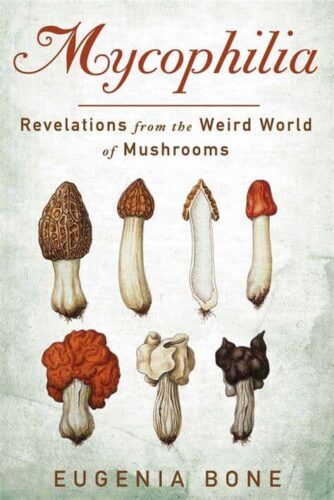 My Kingdom for a Truffle…
My Kingdom for a Truffle…
They’re everywhere! Whether you realize it or not, fungi are present throughout the natural world and are perfectly willing to take advantage of any unnatural worlds we might offer them. Despite their ubiquity, fungi go about most of their business invisible to the human eye, only rarely appearing as a mushroom or a moldy splotch on a chunk of cheddar. In Mycophilia, food journalist and fungal fanatic Eugenia Bone reveals many of the mysteries of mushrooms and explores how fungi impact our lives in myriad ways.
Enthralled by the many culinary applications of mushrooms, Bone chooses to get her hands dirty. Traveling the country on numerous mushroom hunting forays, she and dozens of fellow enthusiasts traipse through the damp forest undergrowth, searching for dinner. But first, she presents a new word: mycetismus – poisoning due to mushrooms. Appropriately, fear of death by mushroom is what keeps most of us from eating any odd looking fungal growths we might find in the woods. Bone explains in detail how mushrooms can kill you and what it might feel like, emphasizing that a knowledgeable and experienced guide is an essential part of any wild mushroom hunting plans. This isn’t a good do-it-yourself project.
After the warning, the author goes on to explain the important role that fungi play in the environment. They can decompose almost any biological substance, but – more interesting and less understood – they are also an essential symbiotic part of any healthy plant’s root system, assisting with nutrient absorption and disease avoidance. Modern agriculture is only now beginning to realize the importance of this latter role and much of the organic farming movement is focused on developing healthy, fungal-friendly soil.
Bone then goes on to discuss the commercial aspects of mushrooms, a human food source that is accelerating in popularity. From annual spring morel obsessions to truffles at $3000 per pound, wild mushrooms are the most valuable legal cash crop in the US. She also explores industrial cultivation of the “pizza mushroom”, the round white button mushrooms available at any grocery store.
Other highlights include a chapter about “shrooms” and the role they may have played in the origin of human religion. She even plans a “trip” for the book, with vividly described and entertaining results. Additionally, in the future fungi may play a role in clean up of oil spills and other toxic sites. They can literally consume crude oil and tar that washes up on shore, resulting in a crop of mushrooms a few weeks later.
Bone is fearless in tackling a topic this large, writing with energy and enthusiasm, even getting naked at one point. Her writing entertains throughout and balances the science and culinary aspects of the topic nicely. While she is primarily a “foodie” she displays plenty of zeal for the other aspects of the fungus world.
Routinely abused, misunderstood and underappreciated, fungi probably don’t rate very highly when people reflect on their most cherished features of the natural world. But as our understanding of the fungal world increases and we start to recognize its many crucial roles, that may change. Mycophilia is a pleasantly readable, wide ranging review of this important topic. I strongly recommend it to those looking to expand their understanding of world around them or for anyone looking for new ideas for their next stir fry.
— D. Driftless
- Best Non-Fiction of 2016 - February 1, 2017
- Little Free Library Series — Savannah - May 22, 2015
- Little Free Library Series — Wyoming - November 30, 2014


Leave A Comment